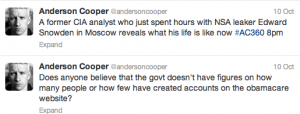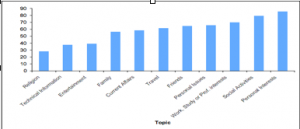Why Blog in the Classroom?
Emily Burton
The purpose of my research is to shed light on how blogging can be a useful tool in the classroom. Pulling from my personal experience as well as my research, I have come to the conclusion that blogging and microblogging in the classroom can develop literacy and writing skills, promote a sense of community inside and outside the classroom, and a sense of purpose in the students.
In a practical sense, classroom blogging is closely tied with an improved literacy in students. Web writing is a valuable tool for students that can encourage good writing for the 21st century. While some professors tend to shy away from the integration of the internet and scholarly writing, the public format of a blog forces students to make clean, concise, and timely pieces. Web writing is also “fundamentally incorporated with the reading comprehension process” (Zawilinski, p. 652). In the article “Sister Classrooms,” Amanda Hagood and Carmel Price discuss that in a course blog, students have more time to think about class materials and give thoughtful responses to prompted questions, making it a better thinking environment than a class discussion. Blogging enables students to absorb class work on their own time, allowing them to truly engross themselves in the subject at hand (Hagood & Price, para. 5). The time that students have to write on their blog gives them space to enhance their writing and critical thinking abilities for the digital medium.
However, keeping a blog does much more than develop students’ reading and writing abilities. Class blogs break the boundaries that separate in-school literacies, such as classroom skills, and out-of-school literacies that require exposure to the world outside of the classroom. From a class blog project, students are given a sense of purpose and fulfillment as they write for an audience beyond just their professors. When asked, “Why should educators take the time to blog?” Ms. Kreul, a teacher at Richards School in Whitefish Bay, Wisconsin, replied, “I think the biggest advantage to blogs is that they provide an authentic audience for student writing and work in general…with a blog, student work can be read by classmates, parents, extended family members…anyone around the world who locates the class blog” (Zawilinski, p. 652). The fact that their writing is capable of affecting a larger audience lets students have ability to fulfill a purpose beyond just their letter grade.
The sense of community in the classroom is one of the most remarkable outcomes of a class blog or microblog project. Class blogs give students an opportunity to read their peers’ thoughts concerning material they post and bounce ideas off one another instead of having the professor be their only audience. “Collectively, students work to create meaning and thereby are involved more actively in the learning process” (Pearson, p. 209). Because the blog posts are public and because students are responding to each other’s ideas online, the role of the professor is more holistic. He or she is a facilitator and fellow participator in the students’ conversation, not just the correcting force who stamps grades on their work. One teacher says of her role in a class blog project, “I don’t find myself pulling my hair out over the careless mistakes they make in formal papers” (Lampinen, para. 5).
In the article “Tweet Me a Story,” Leigh Wright assigns multiple microblogging assignments for her class. Microblogging is defined as “blogging done with severe space or size constraints” (Merriam-Webster). The class would live-tweet during events such as basketball games and lectures from guest speakers. Using a common hashtag allowed the class to form their own community and work toward a common goal. The social aspect of blogging keeps students interested and creates a virtual community in which for them to interact. The fact that students are encouraged to bring their own voice and viewpoint to their schoolwork is not only an exciting change of pace, but also improves the class’s social dynamic. “Benefits extend beyond the classroom,” says high school teacher Michelle Lampinem, “introverted students tend to share more online than they do in person; blogging is an invaluable way for me to get to know them better as people and students.” The authors of “Sister Classrooms” agree that a class blog bolsters the social structures that are naturally a part of learning in a classroom setting (Hagood & Price, para. 4).
I know from personal experience that the online community created by a blog has the potential to incredible impact. In December of 2011, my younger brother Charlie was diagnosed with Ewings Sarcoma. This is a rare form of childhood bone cancer, and the doctors had discovered a tumor in Charlie’s right arm. The news was devastating. In the weeks following the diagnosis, I felt lonely and scared, not knowing what to do with myself. I came home from school many days to an empty house while my parents and Charlie were at Children’s Hospital for chemo treatments, and found myself desperately searching for a way to be a part of his journey although I had a jam-packed Junior year to deal with on the side. That’s when I discovered Caring Bridge. Caring Bridge is a website that allows people to set up a free blog for a loved one who is struggling with illness to keep friends and family updated as the patient goes through treatment, and also to receive words of support when the gestures are needed the most (Ojeda-Zapata para. 2). Each blog includes a photo gallery, a guestbook, and an option to make a tribute donation to Caring Bridge in honor of the patient. I delightfully seized the opportunity and became the author of Charlie’s Caring Bridge website.
(http://www.caringbridge.org/visit/charlieburton2)
We shared the site’s link to close friends and family after I made my first post.
Dec 29, 2011:
Hi Everyone,
Charlie’s first day of chemo went well. We expect to have him home later tonight or tomorrow, yay! He is currently on three different types of chemo. One takes only one minute to administer and another only 15 minutes. One is red and makes his tears and sweat red! We now have a better understanding on how the future looks for him at this point. His current schedule will be 2 days of chemo followed by 12 days off, then 5 days of chemo followed by 9 days off. That will continue for 12 weeks. At that time, he will have surgery on his arm to remove the infected bone. After recovery from surgery, he will go back to the chemo schedule for another several months or so. Charlie hopes to go to school next week for at least a few hours depending on how he is feeling. I have really enjoyed reading all the postings in Charlie’s guestbook. Your kind words mean so much! Thank you for all the support!
– Emily
As Charlie’s site gained more and more of a following, I began to let my guard down and let the blog become a not only a window into my brother’s journey, but a window into my personal journey as a sibling of a cancer patient. I used multi-modal features such as the photo album platform to visually document Charlie’s story. The blog became not only a useful tool for my family and friends who cared about Charlie’s health, but also a necessary outlet in which I could find clarity in the scary and often confusing new chapter of my life.
Dec 31, 2011:
Hi Everybody,
This is Charlie’s second day at home after the chemo. While we are all happy to be out of the hospital, things have been a bit challenging as Charlie adjusts to his chemo drugs. He is tired, nauseous, and can’t eat much. The usual smells of home (candles, Christmas tree, food) make him nauseated. We know that Charlie has been having a little bit of a tough time, but he continues to be brave and face these new challenges with a good attitude. While my parents wouldn’t normally encourage it, playing Call of Duty on the Xbox with his friends (we call this activity “going killing” in our house) is a good distraction for him. It will be a struggle having to adjust to all of Charlie’s new medical needs at home. My parents have to administer his IV antibiotic three times a day. This is given through his central line and takes an hour and a half to run its course. After the hour and a half, the line then needs to be flushed. A visiting nurse came yesterday to teach my parents how to do all this. Needless to say, it will keep them busy. I often come down to the basement in the morning to talk to Charlie about life. This morning, he was telling me about some boys he met in the cancer wing at Children’s who he hopes to befriend. I love how Charlie continues to make the best out of his situation. Despite the difficulties, we are fortunate and happy that we are able to celebrate New Year’s at home and not in the hospital as we originally thought. We know that 2012 will be a year of healing for Charlie, and for that, we celebrate. Thank you for continuing to surround our family with love! Have a very happy New Year!
-Emily
The link to the blog eventually got passed along the grapevine to friends of friends across the country, and even to my Spanish exchange student’s family and friends all the way in Madrid. My little blog project for Charlie had suddenly given my family and I an invaluable support system that practically spanned the globe. From the overwhelming response to my Caring Bridge site, I felt the same sense of accomplishment that students get from their class blogs. Writing for the public eye helped me become a confident author, which is something so special and necessary for college-aged writers who are trapped in the mindset of “will my professor think this is good enough?” After the 36 weeks of chemotherapy and the major surgery to remove Charlie’s cancer site were through, the Caring Bridge garnered just shy of 10,000 total hits, 8 tribute donations, and countless entries in the guestbook. I had no idea that by making a blog I could find confidence in my own life and in my writing, lift up my loved ones, and rally a wider audience around my brother’s cause. My journey with blogging ties together the writing skill, sense of community, and personal accomplishment that students similarly experience while blogging in the classroom.
In a small liberal arts college like Dickinson, I firmly believe that blog projects can be both a useful tool for writing but also a perfect way to get students involved in a community cause. I envision a community service club sponsoring a blog project like the Caring Bridge, where each student is assigned to make a blog for a child who suffers from disease or disability. The students can go out to their homes and spend valuable bonding time with the child, then post on the blog after each meeting. The students would be encouraged to share their blog with their friends so they can generate a community dedicated to their specific child. This blog project can make a suffering young one feel extremely special, and help others support the child and his or her family. A blog post doesn’t have to take up a lot of time in a busy college schedule, yet it can create a powerful impact.
Highlights from Charlie’s Caring Bridge Photo Album:
- Charlie at the Children’s Hospital.
- Charlie and I.
- Charlie on his last day of chemo.
- Charlie and his nurses.
- Charlie upon being declared cancer-free.






















